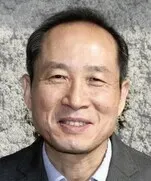hankyoreh
Links to other country sites 다른 나라 사이트 링크
[Column] Imperial tyranny, Korean humiliation


By Park Hyun, editorial writer
While many would have you believe that the fiasco involving over 300 Korean workers being arrested and detained by US immigration authorities has been resolved by allowing the workers to “voluntarily depart” back to Korea, this is far from the truth. Korea as a nation was deeply shocked to witness our workers, who had traveled to the US to work at the request of American investors, shackled at their hands and feet with chains. This barbaric incident will leave a lasting stain on Korea-US relations.
The mass arrests are undoubtedly a wake-up call, a major rupture that opens our eyes to what is happening in the US at this moment. We must heed this warning to close the loopholes and traps in our investment projects with the US. Otherwise, we may eventually face even greater calamity.
To understand what’s at the core of this situation, we must revisit the “Make America Great Again” movement championed by US President Donald Trump. MAGA represents a reactionary movement by white evangelical forces seeking to revert America to a time before the civil rights movement in the 1960s. Its core supporters are low-income, poorly educated white Americans and evangelical Protestants. Trump has become a voice amplifying the anxieties of these groups, whose societal status has been shaken by job losses due to globalization, deepening economic polarization, and a surge in immigration. Trump has incited them to channel their anger toward the established elite and “outsiders,” such as people of color, undocumented immigrants, and Muslims.
Trump is fundamentally a populist and white supremacist. His slogan of “Make America Great Again” would be phrased more accurately as “Make White America Great Again.” His insistence on imposing a 50% tariff specifically on steel and aluminum stems from the fact that white, Protestant populations are concentrated in the American Rust Belt.
The massive crackdown on allegedly undocumented immigrants at the Hyundai-LG Energy Solution plant in Georgia must also be understood within this context. The sight of our workers being led out in chains resembles images of African slaves in the 18th and 19th centuries being dragged out by their owners. The Department of Homeland Security boasted that the raid was “the largest single-site enforcement operation in [its] history,” and Immigration and Customs Enforcement even brazenly released footage of the operation — which clearly risks human rights violations — as if to flaunt these arrests as their achievement.
Far-right white Americans may have rejoiced inwardly at this incident. Even politicians like the governor of Georgia and local lawmakers, who had previously been enthusiastic about hosting the factory, have abruptly changed their stance and joined the chorus of discontent. This shift is likely because it’s difficult to ignore the anti-immigrant sentiment among Americans born into citizenship. The US is in the grip of an irrational frenzy, reminiscent of the McCarthyism that swept through American society in the 1950s. The US could have resolved this visa issue diplomatically by giving Korea advance notice as an ally. Yet, the crackdown — complete with helicopters and armored vehicles, as if to gleefully flaunt their power — can only be explained as a political performance.
The Trump administration’s plan to revive manufacturing in America is a strategy deeply influenced by political calculations rather than economic logic. Having stoked the discontent of the white working class in the Rust Belt to win his presidency, Trump has a strong motive to continue exploiting them politically. While he, as a political leader, may attempt to pursue such policies, these efforts amount to little more than wishful thinking. Historically, such attempts have rarely succeeded. If they had, why did the British Empire, once called a territory where the sun never sets, crumble over time?
Declining industries inevitably relocate to emerging nations over time. Even in Korea, we face difficulties in reviving such industries. How much more challenging would it be for the US, where production costs are at least 30% higher than ours, and over two decades of hollowing-out in manufacturing have collapsed the industrial ecosystem? Trump is dreaming a delusional fantasy of using imperial might to forcibly mobilize allies and reverse this trend. To make matters worse, treating allied workers who are trying their best to assist in realizing this pipe dream as if they are slaves of a vassal state will jeopardize even those projects that had some potential. We’re currently watching the US foolishly shoot itself in the foot.
This incident should prompt us in Korea to comprehensively reassess our investment projects in the US. We agreed to a tariff deal during a transitional period when President Lee Jae Myung had just taken office. Trump’s aggressive tactics forced us to follow Japan’s lead, but we must now take a cold, hard look at the specifics of what we agreed to. The US made outrageous demands on Japan: execute US$550 billion in investments within Trump’s term, provide funds within 45 days if Trump orders it, and hand over 50%-90% of profits to the US. Reports say the US is now making identical demands of us.
Following the footsteps of Japan, the world’s third-largest economy and a quasi-reserve currency nation, could poison our own economy. Rather than yielding to America’s unreasonable demands to avert an immediate crisis, the government must clearly distinguish what we can and cannot do and negotiate with the US. We must bear in mind that even if the manufacturing revival fails, the US, as the world’s largest economy and reserve currency holder, will likely suffer little harm. Our economy, on the other hand, could be severely shaken by a major shock.
Please direct questions or comments to [english@hani.co.kr]

Editorial・opinion
![[Column] Imperial tyranny, Korean humiliation [Column] Imperial tyranny, Korean humiliation](https://flexible.img.hani.co.kr/flexible/normal/500/300/imgdb/original/2025/0912/7617576652278449.jpg) [Column] Imperial tyranny, Korean humiliation
[Column] Imperial tyranny, Korean humiliation![[Correspondent’s column] Cognitive dissonance in MAGA world [Correspondent’s column] Cognitive dissonance in MAGA world](https://flexible.img.hani.co.kr/flexible/normal/500/300/imgdb/original/2025/0912/3417576648512186.jpg) [Correspondent’s column] Cognitive dissonance in MAGA world
[Correspondent’s column] Cognitive dissonance in MAGA world- [Editorial] Korea, US need a ‘gentlemen’s agreement’ on what job creation entails
- [Column] Why MAGA has its eyes set on Korea
- [Column] Lee still has his work cut out for him after summit with Trump
- [Editorial] Is this any way for the US to treat an ally?
- [Column] Lee’s difficult task of striking a balance on Japan
- [Editorial] Multipolar era means Seoul must broaden its diplomacy
- [Column] North and South Korea are no longer pawns in US-China-Russia relations
- [Column] Who we fail when we oversimplify the ‘comfort women’ issue
Most viewed articles
- 1Seoul says US must fix its visa system if it wants Korea’s investments
- 2North Korea said to have exposed numerous US spies after botched 2019 SEAL mission
- 3[Column] Imperial tyranny, Korean humiliation
- 4Freed workers arrive in Korea, one week after ICE raid in Georgia
- 5Korea’s president says firms will be ‘very hesitant’ about investing in US after ICE raid
- 6[Correspondent’s column] Cognitive dissonance in MAGA world
- 7Lee says he won’t sign any tariff deal with US that doesn’t benefit Korea
- 8MAGA’s traveling circus comes to Korea
- 9Korea, US to launch working group to improve visa system for Korean workers
- 10[Column] Why MAGA has its eyes set on Korea